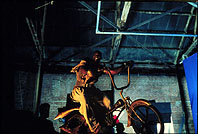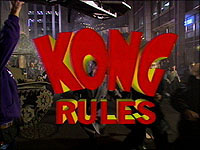 |
|

|
Close Encounters of Another KindModels also play a major role in Independence Day, a spectacular blockbuster opening in July. But, ironically, these "miniatures" were too large for Hollywood studio facilities and had to be housed in the vast hangar of Howard Hughes' Spruce Goose (now part of the Dreamworks SKG backlot). The inventory was impressive: the White House, the Empire State Building and a 60-foot-high alien spaceship, among others. An elite effects team assembled specifically for the film labored for months to create these meticulously detailed replicas—only to see them blown to bits in a matter of seconds.The perpetrators of this devastation are some decidedly hostile aliens bent on world domination—with an assist from veteran pyrotechnician Joe Viscosil. As opposed to visual effects—which come together in post-production as various elements are optically or digitally combined—practical effects like explosions are performed in front of the camera. With sophisticated models like those in Independence Day, there wouldn't be a chance for second or third takes. Ben Burtt explains, "Shooting the White House explosion was like filming a space shuttle launch—there was no margin for error. Behind shields, the effects crew had nine cameras and we had three, including one high-speed, because slow motion gives miniatures a sense of greater mass. The model was set with detonators. At the countdown, Joe triggered the first charge, which set off a flawlessly orchestrated explosion. It looks fantastic in IMAX." Shaquille, Phone Home To many, it seemed that Shaquille O'Neal had mastered the art of flight on the
basketball court. But his latest film Kazaam! put new demands on the
star athlete: take to the skies on a flying bicycle as a distinctly modern
genie. Like ET and Elliot before him, O'Neal was filmed riding his bike on a
blue screen set by LA effects company Rhythm & Hues, recipient of the 1996
Academy Award for visual effects for Babe. The blue background allowed
the image of O'Neal to be combined with footage of the sky, which makes it
appear that he is flying. The final shots are pure fantasy, but the credit goes
to more than the visual effects.
To many, it seemed that Shaquille O'Neal had mastered the art of flight on the
basketball court. But his latest film Kazaam! put new demands on the
star athlete: take to the skies on a flying bicycle as a distinctly modern
genie. Like ET and Elliot before him, O'Neal was filmed riding his bike on a
blue screen set by LA effects company Rhythm & Hues, recipient of the 1996
Academy Award for visual effects for Babe. The blue background allowed
the image of O'Neal to be combined with footage of the sky, which makes it
appear that he is flying. The final shots are pure fantasy, but the credit goes
to more than the visual effects."Directing and performing in an effects film is incredibly demanding. Shaquille was on a bike mounted on a gimbel, repeating the same action for an entire day. He and director Paul Michael Glaser were terrific," says co-producer Laurel Ladevich. That's a Very Nice Rendering, HALFor the 1995 hit Jumanji, filmmakers employed the full arsenal of traditional effects tricks to make the story of a safari board game come alive. Viewers get an inside look at a team of animatronics artists from Amalgamated Dynamics taming the lion—with servo motors and puppeteers. But the newest and most powerful tool is digital technology, which resurrected dinosaurs from extinction in Jurassic Park and allowed the Jumanji team to conjure the lion's digital alter-ego and an elephant stampede out of pixels.There's more to computer-generated imagery than meets the eye. Special Effects follows ILM computer graphics artists to Marine World, where they study the anatomy and movement of real elephants in order make their cyber-pachyderms true-to-life. The startlingly realistic scenes beg the question: what's next? "Synthetic humans are the biggest challenge. Our perceptual system is finely tuned to the subtle nuances that make us human. But everyone's going for it, and `synthetic' actors will be the stars of the digital revolution," predicts Simpson. The Wizards of AhsWith all of the technology at their disposal—from tried-and-true techniques like stop motion and animatronics to the vanguard of computer-generated imagery—special effects artists are poised to take a quantum leap with every new film, only limited by the boundaries of their imaginations. They have to—to keep up with their audiences.Says executive producer Paula Apsell, "People love seeing `the wizard behind the curtain' as much as they love being fooled. They're savvy enough about the process that filmmakers have to work hard to stay a step ahead. It's a continual race for the perfect illusion—and anything can happen." Kelly Tyler is a writer and associate producer for NOVAMAX, the large-format film unit of NOVA/WGBH Boston.  Photo Credits: (1) Peter Iovino copyright 1996 WGBH Educational Foundation, (2) copyright 1996 WGBH Educational Foundation, (3) copyright 1996 WGBH Educational Foundation . Theater Release Dates | Behind the Scenes |